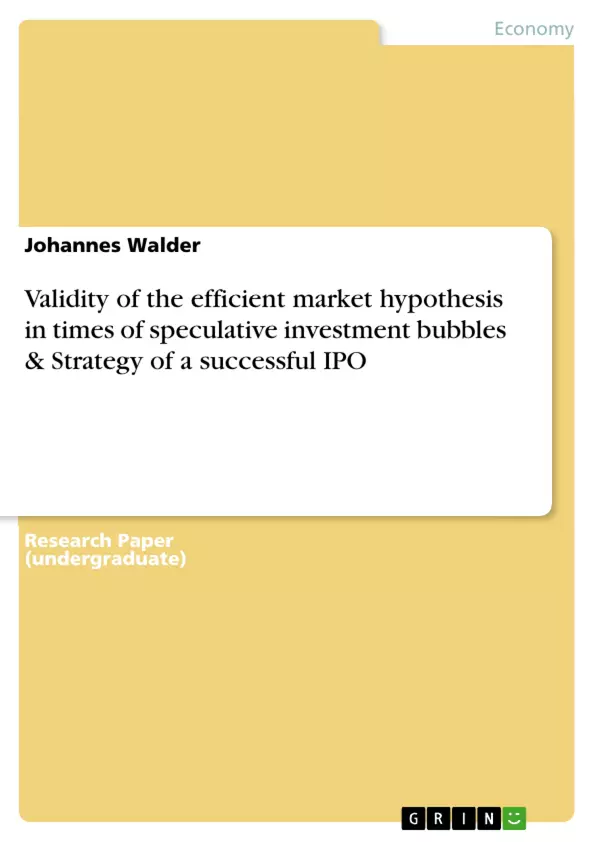It can be assumed that the internet was one of the most influential inventions of the 20th century. The internet opened up completely new ways of communicating and executing businesses. It enabled shopping portals like Amazon or eBay to emerge and revolutionise the shopping experience of millions of customers worldwide. The new economy was a Symbol for seemingly endless possibilities and a market with no limits. However, all those new ways of doing business could not prevent one of the biggest stock market crashes in modern history caused by the dot.com bubble.
This essay examines if the dot.com bubble stands in contradiction to the efficient market hypothesis (EMH) and their underlying assumptions. It will be argued that in the short term the efficient market can be bypassed but it will regulate itself again in the long run.
The second part describes the strategy of a successful initial public offering (IPO) and analyses if the EMH has an impact on this endeavour. This paper will claim that the EMH influences the pricing of stocks and that a long term strategy is a key for a successful IPO.
Inhaltsverzeichnis (Table of Contents)
- Introduction
- The efficient market hypothesis and their assumptions
- Analysis of the dot.com bubble
- The new economy
- Factors leading to the dot.com bubble
- The burst of the bubble
- The dot.com bubble in historic perspective
- Contradictions of the efficient market hypothesis in the face of speculative investment bubbles
- Conclusion of the EMH evaluation
- Strategy for a successful IPO
- Preparation process
- Due diligence
- Marketing and investor relations
- Conclusion of the IPO strategy analysis
Zielsetzung und Themenschwerpunkte (Objectives and Key Themes)
This essay aims to analyze the validity of the efficient market hypothesis (EMH) in the context of speculative investment bubbles, specifically examining the dot.com bubble. It further explores the strategy of a successful initial public offering (IPO) and its relationship to the EMH.
- The efficient market hypothesis and its core assumptions
- The dot.com bubble and its impact on the EMH
- The implications of speculative investment bubbles for market efficiency
- The role of investor behavior and rationality in market dynamics
- The strategic elements of a successful IPO
Zusammenfassung der Kapitel (Chapter Summaries)
- Introduction: The essay introduces the concept of the dot.com bubble and its relevance to the efficient market hypothesis (EMH), highlighting the potential contradictions between the two. It also outlines the paper's focus on analyzing the EMH and the strategy of a successful IPO.
- The efficient market hypothesis and their assumptions: This chapter introduces the three forms of the EMH (weak, semi-strong, and strong), explaining their core assumptions and how they relate to investor behavior and market efficiency. It also discusses the implications of the EMH for both investors and companies issuing new shares.
- Analysis of the dot.com bubble: This section examines the emergence and characteristics of the dot.com bubble, including the rise of the "new economy" and the factors that contributed to the boom. It explores the subsequent crash and the historical impact of the bubble.
- Contradictions of the efficient market hypothesis in the face of speculative investment bubbles: This chapter delves into the potential contradictions between the EMH and speculative investment bubbles, challenging the core assumptions of the EMH in the context of irrational investor behavior and market inefficiencies.
- Conclusion of the EMH evaluation: This chapter presents the conclusions drawn from the analysis of the dot.com bubble and its impact on the EMH, highlighting the potential limitations of the EMH in explaining market behavior during periods of extreme speculation.
- Strategy for a successful IPO: This section outlines the essential steps involved in a successful IPO, focusing on the preparation process, due diligence, and marketing and investor relations. It explores how the EMH influences the pricing of stocks and the importance of a long-term strategy for IPO success.
Schlüsselwörter (Keywords)
The key concepts explored in this paper include the efficient market hypothesis (EMH), speculative investment bubbles, the dot.com bubble, investor rationality, market efficiency, initial public offering (IPO), IPO strategy, and long-term investment strategies.
- Quote paper
- Johannes Walder (Author), 2012, Validity of the efficient market hypothesis in times of speculative investment bubbles & Strategy of a successful IPO, Munich, GRIN Verlag, https://www.grin.com/document/212375



